|
1.
CENTRAL AND WEST AFRICA
Downturn in demand from China contniues
Producers comment that markets remain challenging
especially as there has been a significant downturn in
demand from China.
Demand in China continues to decline, even with prices
for sawn okoume KD dropping to Eur400 per cubic metre
from Equatorial Guinea. As reported earlier exporters
outside of Equatorial Guinea say this cannot be matched as
production and transaction costs continue to climb.
In contrast to the China, demand from Philippine
importers remains strong driven in part due to
reconstruction following severe storms in recent months.
The pace of incoming orders from Vietnam is reported as
stable with no significant price movement reported.
The issue of high stocks in some Middle East countries is
no longer being raised and producers say the market is
starting to recover as stocks decline. Buyers in Europe are
still in holiday mood so there is currently only a trickle of
orders.
Regional update
Cameroon
Heavy rain is affecting operations in the Douala region
while around Yaoundé the weather is more favourable and
not disrupting log deliveries.
Gabon
It has been reported that five mills servicing the Chinese
market have closed due to a lack of orders. These mills do
not have logging concessions so rely on buying in logs so
cash flow is always an issue and some rely heavily on
advance payments, a problem as orders fade.
The wood based panel sector in Gabon remains stable with
strong (but currently quiet) demand in European markets
notably the Netherlands.
It has been reported that to address a vehicle shortage
forestry officers have been allocated addition vehicles to
conduct monitoring operators.
The World Bank and IMF are said to be exerting pressure
on the government to rein in expenditure which has
reportedly led to changes in government priorities. It has
been reported that the government plans to consolidate
ministries into one or two buildings to reduce high
building rental charges.
In related news, the Gabon Review has published an
article by Adrien Nkoghe Essingone, a former Member of
Parliament in Gabon, in which he calls for the lifting of
the log export ban.
The article says “since the ban on log exports the
processing rate has certainly increased but it has not
generated the expected added value in terms of budgetary
resources. Contrary to popular belief, local processing
does not always create more added value than the export
of raw products”.
See:https://www.gabonreview.com/tribune-pour-un-gabon-
forestier-le-pari-de-la-souverainete-economique/
Congo
Some Malaysian mills operating in the Congo have
reportedly cut output due to market pressures, especially
the downturn in demand from China and are shifting to
other markets to sustain operations. However, plywood
exports to Europe and Morocco remain stable.
Central African Republic
The rain season has returned to the CAR but there are no
reports of disruptions. Mills produce primarily for
European markets shipping ayous, iroko, some assamela
and sipo. The main concerns of producers are the poor
road conditions, perceived political instability and the long
distance transport to ports.
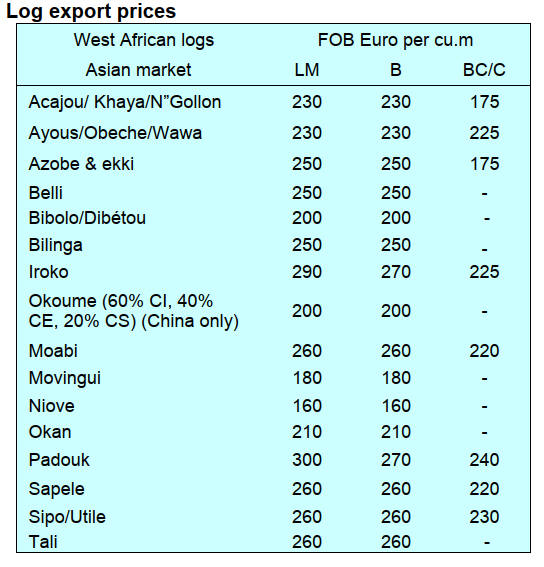
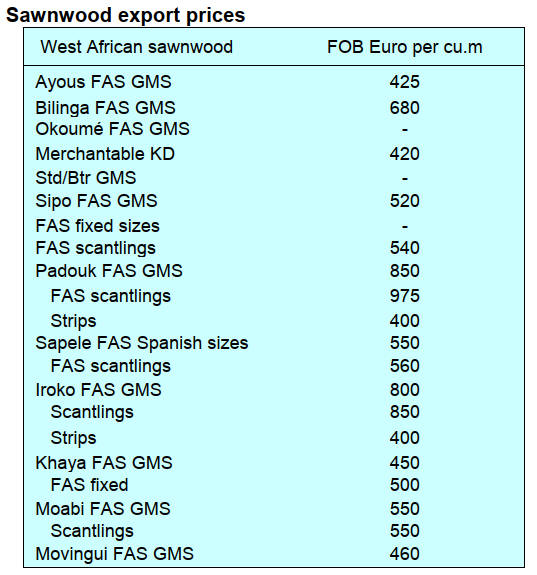
2.
GHANA
40% increase in stumpage fees agreed
The Forestry Commission met on August 11 with chiefs
and timber industry players to deliberate and review
Timber Stumpage fees. The review became necessary due
to the depreciation of the local currency and high inflation
rates. The old stumpage fees had not been reviewed in the
last six years.
Many present stated that “the review of the stumpage fees
is long overdue and has become necessary to be evaluated
as things have changed since the last review.”
The Chief Executive of the Forestry Commission, Mr.
John Allotey, stated that the revenue expected from the
stumpage would be given to the appropriate parties so they
get what is due to them according to the laws governing
the state.
The Executive Director of the Forest Services Division,
Mr. Hugh Brown, presented a Review of Timber
Stumpage Fees 2024”. According to him, stumpages are in
two parts. 50% is retained by the FC and the other half is
paid as royalties to chiefs. He went on to explain how the
stumpage fee is calculated.
According to Mr. Brown, one of the key things that has
affected the stumpage is the depreciation of the local
currency and some of the difficulties the Timber Industry
Association has faced in their businesses. This includes the
impact of external inflation on the cost of machinery and
high and rising operational costs, for example fuel, labour,
electricity and forest protection measures.
The Commission proposed a 50% increase in the current
stumpage fees to be implemented effective 1st September
this year.
The Commission also proposed a thorough stumpage fee
review process, which should be undertaken through a
multi-stakeholder consultative process in the first or
second quarter of 2025. He added that the Commission
recommended regular annual reviews to be undertaken to
progressively bring stumpage fees charged by the FC in
line with the legal provisions under the law.
The CEO of the Ghana Timber Association (GTA), Nana
Dwomoh Sarpong, appealed for a reduction of the
stumpage fee increment from 50% to 30%. He noted that
COVID-19 is still affecting the industry as they are still
paying COVID-19 tax.
From the deliberations, thoughts, and considerations, all
parties agreed to reduce the proposed 50% increment to
40%, effective 15th September, 2024.
See: https://fcghana.org/timber-stumpage-fees-reviewed/
Certificate course in Natural Resource Management
The Forestry Commission Training Centre (FCTC), which
is affiliated to the University of Energy and Natural
Resources (UENR) in Sunyani, has introduced an 18-
months Certificate in Natural Resource Management
(CNRM) Programme.
At its opening ceremony at Ejisu in the Ashanti Region
sixty-seven freshmen and women entered the programme.
The course is expected to produce mid-level technicians
for forestry and wildlife operations.
In his welcoming address, Dr. Andy Osei Okrah, Director
of FCTC, indicated that the event was to celebrate the
matriculation and unique inauguration ceremony for the
Certificate programme.
Mr. John Allotey, Chief Executive of the Forestry
Commission, said he was excited to witness the first
matriculation of the CNRM programme as the
Commission needs a well-trained and prepared workforce
for the technical task in the sector.
As part of measures to maintain standards and improve its
human resources to address the challenge of limited
technical expertise the Wood Industry Training Centre was
restructured into FCTC with the new focus to provide
training for Forestry Commission (FC) staff and allied
institutions in the forestry sector. That initiative was to
bring back the training of technical-level professionals for
the Commission and the industry.
See: https://fcghana.org/fctc-holds-maiden-cnrm-matriculation-
ceremony/
Ghana’s billet export volume dips 40%
According to data published by the Timber Industry
Development Division (TIDD) of the Forestry
Commission, Ghana’s billet export volume dropped to
4,385cu.m in the first five months of 2024, from 7,267
cu.m registered in 2024 representing a 40% decline year-
on-year.
This also resulted in a corresponding 42% drop in the total
receipts for the product for the period under consideration.
Cumulative wood export totals for the first five months of
January to May 2024 compared to same period in 2023 are
tabulated below;
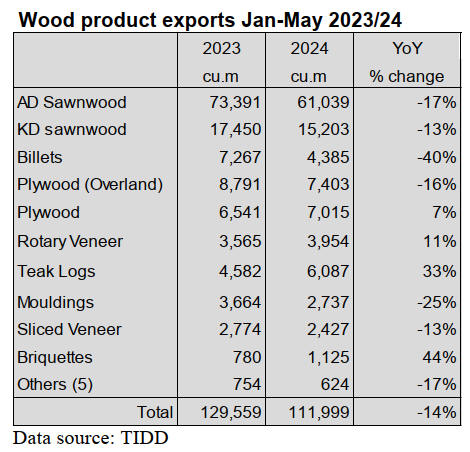
The low billet export volume contributed to the poor
performance of total exports for the period, which declined
by 14% and 12% respectively. For the period reviewed
only one company exported just 16.5 cu.m in May 2024
compared to the total volume of 330 cu.m valued at Eur
106,340 in April.
Billets are a major component of the country’s primary
product exports which together with boules, kindling,
sawnwood), rollboard and teak logs earned Eur 28.54
million from 71,963 cu.m of the total export of wood
products between January and May 2024. These figures
indicated decreases of 16% and 14% in volume and value
respectively compared to the timber export figures
between January and May 2023. The major species for
billets are gmelina and teak.
India is the main destination for Ghana’s billets, which
along with sawnwood, sliced veneer and teak logs was the
leading Asian importer of Ghana’s wood products.
Targeted support for SMEs to boost value addition
According to the Institute of Statistical, Social and
Economic Research (ISSER) at the University of Ghana,
Small and Medium-sized Enterprises (SMEs) in key
sectors of the country could promote higher value addition
to their products and services if they could secure
financing.
ISSER recommended targeted financial support for these
SMEs in their 2024 Mid-Year Budget Review titled ‘A
Critical Assessment of the 2024 Mid-Year Budget by
ISSER’. By implementing targeted measures, ISSER
believes Ghana can significantly enhance the capacity of
SMEs to add value, stimulate economic growth and attract
investment into vital sectors.
In a bid to support the country’s SMEs the government is
investing 8.2 billion Ghana cedis through the newly
launched SME Growth and Opportunity Programme.
During the launch President Nana Akufo-Addo
highlighted the modalities of the programme and indicated
it will be coordinated by the Ministry of Finance and the
Ministry of Trade and Industry.
There are around 850,000 SMEs in Ghana and they
contribute significantly to the economy accounting for an
estimated constituting around 70% GDP and providing
80% of private sector employment. Despite their
significant contribution to the country’s economy the
sector battles several challenges, especially access to
credit.
See: https://www.myjoyonline.com/isser-urges-targeted-support-
for-smes-to-boost-value-addition-in-key-sectors/


3. MALAYSIA
Ringgit strenghthens against the US dollar
On 5 August the Malaysian ringgit climbed to its strongest
against the dollar since April 2023, supported by a solid
economy as weak US economic data spurred selling of the
dollar. The ringgit had slumped since early this year,
dropping in late February to its weakest level since 1971.
The rebound came after US jobs data released
Friday showed a rise in the unemployment rate.
Sawn rubberwood shortage
For many years, according to Muar Furniture Association
president Steve Ong, furniture makers have been facing a
shortage of rubberwood. Speaking to the Star newspaper
Ong said the impact was more noticeable recently because
of changes in plantation practices and the high level of
rubberood veneer exports.
Ong said about 80% of wooden furniture in Malaysia is
produced using rubberwood. He urged the government to
intervene by limiting the export of rubberwood and to
prioritise local manufacturing.
The Furniture Association was pushing for replanting
programmes to salvage the situation hoping that such
efforts could be undertaken through a systematic
replanting plan to produce logs suitable for sawnwood
production. Ong said rubber trees planted for timber can
be harvested in seven to eight years as compared to
harvesting rubberwood from trees that produce latex
which take a period of 20 to 25 years.
See:
https://www.thestar.com.my/news/nation/2024/07/28/rubber-
wood-shortage-hits-furniture-makers
Conservation of mangrove ecosystems
A total of 20,000 mangrove trees were planted through a
strategic collaboration between Yayasan Hijau Malaysia,
Sabah Forestry Department and Wiwynn Technology
Service Malaysia in Hutan Simpan Tawau, Sungai
Mangkalitan.
Natural Resources and Environmental Sustainability
(NRES) Minister, Nik Nazmi Nik Ahmad, said the
initiative held in conjunction with the International Day
for the Conservation of Mangrove Ecosystem 2024, marks
another significant milestone for mangrove conservation
in Malaysia.
Nik Nazmi added that since 2005, the government took
significant steps to conserve and rehabilitate mangrove
areas through the Tree Planting Programme with
Mangroves and Suitable Species along National
Coastlines, an initiative following the devastating tsunami
in December 2004.
See: https://www.dailyexpress.com.my/news/239013/undefined/
Cooperation to improve upstream and downstream
sectors
The Malaysian Timber Council (MTC) aims to strengthen
its partnership with the Sarawak Timber Industry
Development Corporation (STIDC) and the private sector
towards supporting the growth of the nation’s woodbased
industry. MTC Chief Executive Officer, Noraihan Abdul
Rahman, acknowledged that the STIDC has clear plans to
improve both the upstream and downstream sectors of
Sarawak’s wood-based industry. Noraihan also said there
are opportunities for collaborative efforts in boosting
Malaysia’s wood-based and bamboo industries.
STIDC General Manager, Zainal Abidin Abdullah,
indicated that the STIDC aims to transform and modernise
the timber industry with the goal of increasing export
earnings to RM8 billion by 2030. Zainal Abidin pointed
out that a Sarawak Bamboo Community Project involved
146 participants and covered more than 63 hectares, while
the commercial bamboo plantations had expanded to 3,597
hectares across Sarawak.
See:
http://theborneopost.pressreader.com/article/281599540773234
New Permanent Forest for Sarawak
A total of 31 areas in Sarawak have been proposed as new
Permanent Forest Estates (PFE) covering an estimated
814,437 hectares according to Deputy Premier, Awang
Tengah Ali Hasan. Currently, Sarawak has 67 Totally
Protected Areas (TPA) with a total area of more than 2.1
million hectares which includes over 847,000 hectares of
land and 1.2 million hectares of water bodies as well as
118 PFEs with a total area of 3,960,381 hectares.
“I hope that the federal government would provide more
funding through the Ecological Fiscal Transfer (EFT) for
conservation activities” said the Deputy Premier.
Regarding mangrove forests, Awang Tengah disclosed
that Sarawak has so far gazetted 12,950 hectares or 19% of
the total mangrove forest area in Sarawak as TPAs.
Additionally, 11,084 hectares or 16% of the total
mangrove forest area have been designated as PFE.
See: https://www.theborneopost.com/2024/07/26/31-areas-in-
sarawak-proposed-as-new-permanent-forest-estates-says-awg-
tengah/
First carbon credits auction
Bursa Malaysia announced that its subsidiary Bursa
Carbon Exchange (BCX) conducted the first Malaysian
Carbon Credit Auction with carbon credits from the
Kuamut Rainforest Conservation Project in Sabah. This
represented a crucial step in Malaysian nature-based
carbon project showcasing Malaysia’s capacity to develop
its own carbon projects to international standards.
The auction attracted participation from businesses and
organisations committed to reduce their environmental
impact through several credible pathways, one of them by
offsetting hard to abate GHG emissions through carbon
credits. The auction of the domestic forest protection and
regeneration project was cleared at RM50 (roughly
US$11.30) per contract.
A key factor for this conservation project is that it delivers
tangible climate, community and biodiversity co-benefits
earning itself a Gold Level for Climate status under the
Climate, Community and Biodiversity (CCB) Standard.
See:
https://theborneopost.pressreader.com/article/282175066372199
4.
INDONESIA
Export Benchmark Price (HPE) of Wood for
August
The following lists benchmark prices 1-31 August.

Processed Wood (prices per cu.m)
Processed wood products which are leveled on all four
sides so that the surface becomes even and smooth with
the provisions of a cross-sectional area of 1,000 sq.mm to
4,000 sq.mm (ex 4407.11.00 to ex 4407.99.90)
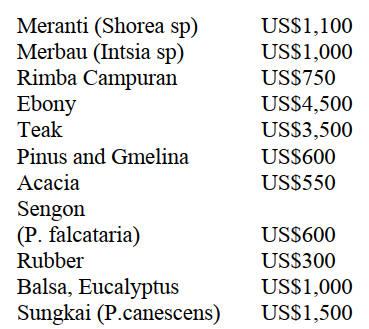
Processed wood products which are leveled on all
four
sides so that the surface becomes even and smooth with
the provisions of a cross-sectional area of 4,000 sq.mm to
10,000 sq. mm (ex 4407.11.00 to ex 4407.99.90)

Processed wood products which are leveled on all four
sides so that the surface becomes even and smooth with
the provisions of a cross-sectional area of 10,000 sq.mm to
15,000 sq.mm (ex 4407.11.00 to ex 4407.99.90)

See:https://jdih.kemendag.go.id/pdf/Regulasi/2024/964_Kepmen
dag%20HPE%20dan%20HR%20Produk%20Pertanian%20dan%
20Kehutanan%20Agustus%202024%20dan%20Lampiran.pdf
31 million cubic metres of Acacia logs in 2023
Statistics Indonesia (BPS) data shows that Indonesia
produced 68.22 million cubic metrs of roundwood in
2023. Acacia was the largest contributor to roundwood
production, accounting for 31.11 million cubic metres or
45.61% of the total, followed by the mixed tropical
hardwood group with 30.93 million cubic metres (45.3%)
In 2023, Sumatra was the largest roundwood producing
region of the country, with a volume reaching 46.10
million cubic metres or 67.57% of total national
production. Next came Kalimantan with 12.09 million
cubic metre (17.73%) and followed by Java with 8.67
million cubic metres (12.7%).
See: https://databoks.katadata.co.id/datapublish/2024/07/29/ini-
jenis-kayu-yang-banyak-diproduksi-indonesia-pada-2023
Indonesia is largest rattan products exporter, says
ministry
Indonesia is the world’s largest exporter of rattan products,
according to the Indonesian Ministry of Industry. The
value of Indonesia's rattan exports hit USD158.5 million,
accounting for 42.2% of the global rattan product trade of
US$375.6 million.
The ministry's Agro-Industry Director General, Putu Juli
Ardika, said Indonesia accounts for 80% of rattan on the
global market, noting that a total of 306 rattan species are
found in the country. However, only 28 species have been
utilised commercially.
According to data released by the ministry last year, the
average monthly production volume of the national rattan
furniture industry was 284,800 tonnes while that of the
national rattan processing industry stood at 17,600 tonnes.
The ministry is actively promoting improvements in the
rattan and wood supply chain for the furniture and craft
industry.
It is hoped this will have a positive impact on enhancing
the overall performance and competitiveness of these
sectors.
See:https://industri.kontan.co.id/news/kemenperin-pacu-
optimalisasi-rantai-pasok-industri-rotan
and
https://forestinsights.id/kemenperin-dorong-efisiensi-rantai-
pasok-rotan-pacu-daya-saing-industri-furnitur/
Indonesia launches SOIFO 2024 report
The Indonesian Minister of Environment and Forestry, Siti
Nurbaya, has unveiled the 2024 edition of the ‘State of
Indonesia’s Forests’ (SOIFO) report. The publication
provides updated data and insights into the condition of
Indonesia’s forests, addressing current challenges and
future opportunities in forest management. The launch
event took place during the 27th session of the FAO
Committee on Forestry (COFO) at FAO headquarters in
Rome.
During the event, Minister Siti introduced the National
Forest Monitoring System (SIMONTANA), a platform
designed to support sustainable forest management and
climate resilience as well as to enhance international
collaboration. “SIMONTANA is an integrated monitoring
platform featuring remote sensing and terrestrial
technologies.
See:
https://nasional.sindonews.com/read/1423391/15/peluncuran-
soifo-2024-platform-simontana-pantau-hutan-indonesia-secara-
akurat-1721984862
and
https://news.detik.com/berita/d-7450511/klhk-bakal-luncurkan-
buku-the-state-of-indonesias-forests-2024-di-roma
Field inspections to improve forestry data accuracy
Given the crucial role of the information in policy making,
Indonesia’s Ministry of Environment and Forestry
(KLHK) ensures the country’s geospatial forestry-related
data is accurate by conducting field checks. During a
recent podcast, Hanif Faisol Nurofiq, Director General of
Forestry Planning and Environmental Management
(PKTL), at the ministry explained that the geospatial
technology used in the One Map Indonesia Policy has
good accuracy because field inspections ensure conformity
between satellite images and facts on the ground.
See: https://www.antaranews.com/berita/4223839/klhk-perkuat-
akurasi-data-kehutanan-dengan-pemeriksaan-lapangan
Carbon trading in Indonesia
Indonesia's carbon trading market is still relatively small
but the government sees it as key to the country’s aim of
cutting carbon emissions by 43.2% by 2030. Elen Setiadi,
Deputy for Business Development and State-Owned
Enterprises Innovation at the Coordinating Ministry for
Economic Affairs, reported that Indonesia's carbon trading
market has reached a transaction value of Rp 36.7 billion
(US$2.26 million) since its launch in September 2023, to
June 2024. The trading volume amounted to 608,000 tons
of carbon dioxide (CO2) equivalent.
The global market for CO2 permits reached a record 881
billion euros (US$948.75 billion) in 2023, marking a 2%
increase from the previous year, according to analysts at
the London Stock Exchange Group (LSEG) in February.
The EU's emissions trading system (ETS) was worth
around €770 billion (US$829 billion), representing 87% of
the global total. The North American markets were valued
at a combined €71.4 billion (US$76.9 billion), and the
Chinese market at €2.3 billion (US$2.5 billion).
"Carbon trading is expected to be a vital instrument in
reducing greenhouse gas emissions and achieving
decarbonization targets," said Elen during Carbon Trading
and Market in Indonesia 2024 webinar in Jakarta recently.
In the first half of 2024, Indonesia recorded a carbon
transaction value of Rp 5.9 billion (US$0.37 million) with
a trading volume of 114,500 tons of CO2 equivalent.
See:https://jakartaglobe.id/business/carbon-trading-in-indonesia-
reaches-226-million-far-behind-global-leaders
and
https://www.antaranews.com/berita/4210875/per-juni-2024-
pemerintah-catat-transaksi-bursa-karbon-rp367-miliar
Carbon tax rules prepared
Coordinating Minister for Economic Affairs, Airlangga
Hartarto, revealed that rules for a carbon tax have been
prepared. However, Airlangga has not been able to
confirm when the tax will be implemented.
Previously, Deputy for BUMN Business Development,
Research and Innovation of the Coordinating Ministry for
the Economy, Elen Setiadi, said that the discussion of the
Draft Government Regulation (RPP) on the Carbon Tax
Roadmap was still ongoing. Elen said that, based on the
RPP, the Carbon Tax Roadmap is proposed initially to
only regulate application of the tax for power generation
sub-sectors or in this case, steam power plants (PLTU). In
the second stage it will extend to fossil fuels used in the
transportation sector.
See: https://voi.id/en/economy/401506
Over 1 million ha. social forestry concessions for
communities
The Indonesian government has set a target of 12.7 million
hectares of land being allocated for community forest
management access. To date, 1.07 million hectares has
been allocated for this purpose under the Social Forestry
Decree (SK), and a further 43,000 hectares as Agrarian
Reform Objective Land (TORA). Additional lands are
being allocated under the decree for people's oil palm land,
and through environmental fund service certificates for the
community.
During the LIKE 2 Festival in Jakarta, Minister of
Environment and Forestry, Siti Nurbaya, announced an
additional Social Forestry Decree for customary forests
covering 15,879 hectares and a decree for rejuvenation of
people’s oil palm land covering 37,000 hectares.
"With the submission of the Social Forestry Decree, the
realisation of social forestry has now reached 8.018
million hectares for 1.4 million Heads of Families (KK),”
stated Siti Nurbaya. She said the indicative area of
customary forests has been set at 1.11 million hectares and
265,000 hectares have been determined through a decree.
In total, 1.37 million hectares of customary forests have
been designated for 138 indigenous community groups.
She stated that the Indonesian government will continue
this process.
See: https://www.rri.co.id/nasional/890138/pemerintah-serahkan-
sk-hutan-sosial-seluas-jutaan-hektare
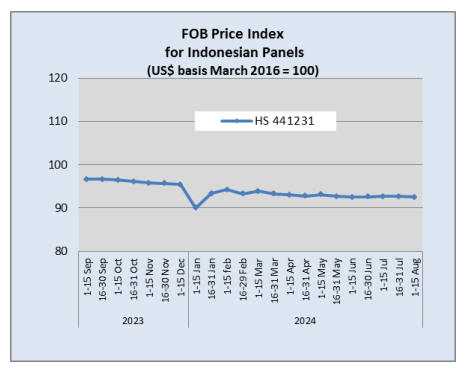
5.
MYANMAR
Economic instability
The crisis in Myanmar reached a new level of severity
after the State Administration Council (SAC) extended its
rule for the sixth time in July 2024. This extension came
alongside the appointment of General Min Aung Hlaing as
the new Acting President.
The economy is in a serious situation. The exchange rate
has deteriorated sharply with the kyat plummeting from
1,300 kyats per US dollar in January 2021 to a staggering
6,000+ kyats per dollar in August 2024. This dramatic
depreciation has had devastating effects on the economy.
The government’s inability to stabilise the economy is
evident and the economic crisis is exacerbating the overall
humanitarian situation in the country according to the
regioal media.
The SAC has stated that it plans to hold elections in 2025.
The dissolution of the National League for Democracy
(NLD) under a new military-drafted electoral law has
further undermined the credibility of any future elections.
See:https://www.frontiermyanmar.net/en/myanmar-junta-
extends-state-of-emergency-by-six-months/
and
https://www.frontiermyanmar.net/en/united-wa-state-army-
moves-into-strategic-town-in-northern-shan-state/
Efforts to restore peace
The Japanese media has reported Chinese Foreign
Minister Wang Yi was to visit Myanmar mid-August
saying there are growing suggestions from China for the
SAC to restore peace.
Wang's visit to Myanmar comes after his special envoy for
Asian affairs, Deng Xijun, held talks with Myanmar leader
Min Aung Hlaing in early August
See: https://asia.nikkei.com/Politics/International-
relations/China-s-top-envoy-to-meet-military-regime-officials-in-
Myanmar
Floods – an additional burden to farmers
The recent decrease in the reference price for rice has
added to the burden on farmers which have recently seen
floods damage much of the rice crop. In addition, price
controls have disrupted supply chains for essential such as
fertilisers and fuel. Flooding in the Irrawaddy Region is
anticipated to reduce rice yields by up to two-thirds.
Price control on imported items
The media has reported the government is set to introduce
reference prices for imported goods. The Ministry of
Economy and Commerce has required that import licenses
and declarations comply with these reference prices.
It is reported that an Import Value Verification Team has
reviewed 373 HS Code lines and confirmed reference
prices for 3,279 product types. To combat the surge in
commodity prices reference prices have been set for
essential items such as rice, oil, fuel, and agricultural
inputs. However, economic observers argue that these
measures and the imposition of fixed prices are not
sustainable long-term solutions.
See: https://burmese.dvb.no/post/663829
and
https://burmese.dvb.no/post/663626
Power supply shut down due to civil unrest
Regional and international media outlets have reported
Sembcorp Industries has suspended operations at its
Myingyan Independent Power Plant in Mandalay. The
decision came in response to escalating civil unrest in the
region, including in the Myingyan township, where its 225
megawatt (MW) gas-fired power plant Sembcorp
Myingyan is located.
The Singapore-based company said in a statement that it
will resume operations at the plant as soon as reasonably
practicable once conditions are safe.
See: https://www.bangkokpost.com/world/2845821/myanmar-
power-plant-shut-down-amid-escalating-unrest
6.
INDIA
Wood panel price index
climbs
The annual rate of inflation based on the India Wholesale
Price Index (WPI) was 3.36% in June 2024. The positive
rate of inflation was primarily due to increase in prices of
food, manufactured food products, crude petroleum and
natural gas, mineral oils and other manufacturing. The
index increased to 141.9 in June 2024 up from 141.7 for
May, 2024.
Out of the 22 NIC two-digit groups for manufactured
products, 8 groups witnessed an increase in prices, 10
groups witnessed a decrease in prices and 4 groups
witnessed no change in prices.
The price index for wood panels continued to climb in
June on the back of firm demand. The price index for
wood veneers moved a little higher while the index for
sawnwood fell slightly.
Some of the groups that recorded decreases in prices were
basic metals, other non-metallic mineral products,
fabricated metal products, pharmaceuticals, medicinal
chemical and botanical products, machinery and
equipment.
See: https://eaindustry.nic.in/pdf_files/cmonthly.pdf
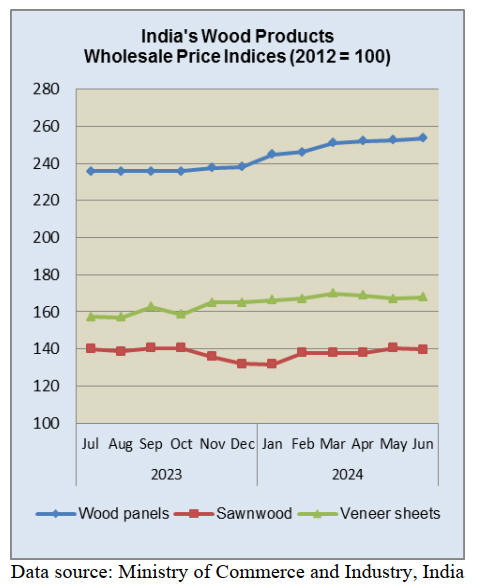
Imported panel prices rising –
difficulties with
shipments
Ply reporter has an article discussing how disrupted sea
freight and logistic issues are seriously impacting the
panel markets with shipments from Vietnam especially
being affected as container freight rates surge again. In
addition, rising adhesive costs are another factor pushing
up FOB prices for imported panels
Rising prices for imported panels has brought some relief
for domestic manufacturers who have recently increased
panel prices.
See: Plyreporter.com June issue
and
https://www.plyreporter.com/article/153952/sudden-container-
crunch-may-take-its-toll-on-core-veneer-imports-from-vietnam-
and-tanzania
Economy highly dependent on nature
A recent statement from the World Economic Forum
Centre for Nature and Climate highlights how India’s
economy is highly dependent on nature and extremely
vulnerable to climate risks. The starement says “third of its
GDP comes from sectors greatly reliant on nature.
Research has found that the climate crisis could cost the
country from 6.4% to more than 10% of its national
income by 2100, taking 50 million more people back into
poverty.
Against this background, a new survey of India’s largest
companies by the World Economic Forum shows that they
have made strong commitments to sustainability and
natural climate solutions (NCS), which aim to protect,
conserve, restore and sustainably manage terrestrial,
freshwater, coastal and marine ecosystems“.
See: https://www.weforum.org/agenda/2024/08/india-economy-
natural-climate-solutions/
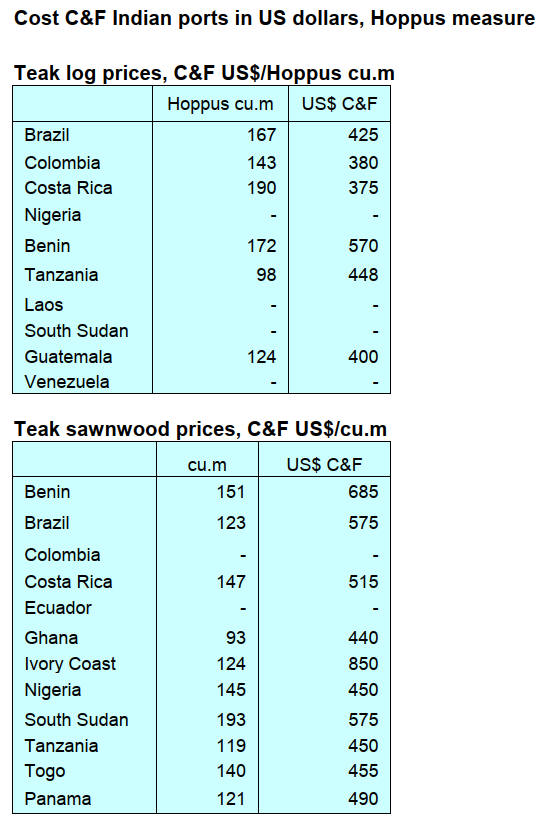 
7.
VIETNAM
Wood and Wood Product (W&WP) trade
highlights
According to Vietnam Customs W&WP exports in July
2024 reached US$1.3 billion, up 4% compared to June
2024 and up 16% compared to July 2023.
Of this WP exports, alone contributed US$915 million, up
7% compared to June 2024 and up 21.6% compared to
July 2023.
In the first 7 months of 2024 W&WP exports were
estimated at US$8.8 billion, up 22% over the same period
in 2023. Of this, WP exports are estimated at US$5.98
billion, up 22% over the same period in 2023.
W&WP exports to the US in July 2024 earned US$743
million, up 4% compared to June 2024 and up 22%
compared to July 2023. In the first 7 months of 2024 WP
exports totalled US$4.8 billion, up 21% over the same
period in 2023.
Exports of living-room and dining-room furniture in July
2024 reached US$215 million, up 15% compared to July
2023. In the first 7 months of 2024 exports of living and
dining-room furniture brought in about US$1.25 billion,
up 23% over the same period in 2023.
Vietnam's W&WP imports in July 2024 were valued at
US$260 million, up 12% compared to June 2024 and up
37% compared to July 2023. In the first 7 months of 2024
W&WP imports cost US$1.5 billion, up 23% over the
same period in 2023.
According to statistics from the General Department of
Customs imports of raw wood (log and sawnwood in June
2024 reached 461,600 cu.m, worth US$151.8 million,
down 8% in volume and 9% in value compared to May
2024. Compared to June 2023, imports increased by 12%
in volume and 12% in value. In the first 6 months of 2024
imports of raw wood totalled 2.48 million cu.m worth
US$821.8 million, up 16% in volume and 9%. in value
over the same period in 2023.
NTFP exports in June 2024 reached US$70.18 million, up
6% compared to May 2024 and up 1% over the same
period in 2023. In the first half of 2024 NTFP exports
earned US$408.26 million, up 14% over the same period
in 2023.
According to preliminary statistics exports of wood and
wood products to the EU market in July 2024 contributed
US$36.6 million, up 39% compared to July 2023. In the
first 7 months of 2024 W&WP exports to the EU came to
US$313.6 million, up 33% over the same period in 2023.
Vietnam's office furniture exports in July 2024 reached
US$29 million, up 23% compared to July 2023. Generally,
in the first 7 months of 2024, office furniture exports
earned US$172 million, up 12% over the same period in
2023.
Vietnam's poplar imports in July 2024 amounted to 39,200
cu.m, worth US$15.3 million, up 12% in volume and 12%
in value compared to June 2024.
However, compared to July 2023 poplar imports increased
by 40% in volume and 30% in value. In the first 7 months
of 2024, imports of raw wood accounted for 211.9 million
cu.m, worth US$80.8 million, up 21% in volume and 8%
in value over the same period in 2023.
Vietnam’s imports of raw wood from Africa in July 2024
decreased slightly, amounting to 70,000 cu.m, with a value
of US$17 million, down 5% in volume and value
compared to June 2024. This brought the total amount of
raw wood imported from Africa in the first 7 months of
2024 to 533,460 cu.m
Imports had a value of US$142.76 million, up 111% in
volume but down 3% in value over the same period in
2023.
Most earnings from carbon credits distributed to
localities
Vietnam has received a US$51.5 million payment from the
World Bank for verified emissions reductions (carbon
credits) said Tran Quang Bao, Director of the Department
of Forestry.
Around 80% of this sum has been distributed to six north
central provinces and the remaining 20% will be
distributed to the localities.
Regarding benefit sharing, which refers to how the value
created from the sale of carbon credits is distributed, Bảo
said that the Government issued a decree on piloting the
transfer of emission reduction results and financial
management of greenhouse gas emission reduction
payment agreements in the North Central Region.
Accordingly, only 0.5% will be used to coordinate the
general agreements and 3% to perform measurement,
control, supervision, training and technical guidance. The
balance is to be allocated to targeted localities.
Based on the contracted forest area the localities will
allocate funds to people and communities that signed
contracts to protect and manage the forests.
Presently, the Ministry of Agriculture has issued a benefit-
sharing plan and is organising training on how to distribute
benefits to localities. The main beneficiaries are
communities, ethnic minorities and forest keepers.
According to the Forestry Department, the Emission
Reductions Payment Agreement (ERPA) in the North
Central Region was signed on October 22, 2020, between
the agriculture ministry and the International Bank for
Reconstruction and Development (IBRD) under the World
Bank Group as the Trustee of the Forest Carbon
Partnership Facility (FCPF).
The ERPA aims at transferring reduced emissions of 10.3
million tonnes of CO2 in the northern part of the central
region in 2018-2024 to the FCPF via the World Bank, with
the unit price of US$5 per tonne of CO2, worth US$51.5
million in total.
About 95% of the transferred results will be returned to
Việt Nam to contribute to the national commitment to
greenhouse gas emissions to obtain the goals of the Paris
Agreement on climate change approved at COP21.
According to the Forestry Department, Việt Nam has not
had a mandatory market for carbon credits. The transfer of
emission reduction results is carried out through bilateral
agreements between relevant parties.
Regarding the forest carbon credit market, the Prime
Minister has assigned the agriculture ministry to
implement two agreements to transfer emissions reduction
results including the ERPA in the north central region and
another ERPA in the south central and Central Highlands
regions.
In the ERPA in the south central and Central Highlands
regions, Việt Nam transfers to LEAF/Emergent 5.15
million tonnes of CO2 to reduce emissions from forests in
the regions in the 2022-2026 period.
LEAF/Emergent will pay for this service at a minimum
price of US$10 per ton of CO2 with a total value of
US$51.5 million. The area of commercial and service
forests registered to reduce emissions is 4.26 million ha,
including 3.24 million ha of natural forests and 1.02
million ha of planted forests.
See: https://vietnamnews.vn/environment/1653145/most-
revenues-from-carbon-credits-distributed-to-localities-
official.html
Dual benefits for the Vietnamese wood industry from
creating carbon credits
During the period 2010-2020 the average annual net
emissions in Vietnam’s forestry is about negative 40
million tonnes of CO2 equivalent.
If converted into monetary value, reducing 40 million
tonness of CO2 is equivalent to about VND3,500 billion
with the assumption that the cost of reducing emissions of
1 tonne of CO2 is equivalent to US$5.
From an investor's perspective, according to Mr. Nguyen
Ngoc Tung, Director of VinaCarbon Climate Impact Fund,
the wood industry has great potential in creating carbon
credits to compensate for other industries and help
Vietnam reach net zero emissions by 2050. Vietnam has
more than 14 million hectares of forests, of which nearly
half are production forests.
According to Mr. Tung, if wood industry enterprises are
aware that investing in sustainable development and
reducing emissions is an inevitable and necessary trend
that must be implemented, their revenue will not only
come from wood processing activities and forest products
but also from carbon credits.
At the same time, investing in reducing emissions for the
wood industry also means that businesses comply with
international regulations on sustainable forest management
and exploitation, thus, it will increase competitiveness and
the ability to penetrate markets like the EU, bringing
higher value to businesses' exports.
Vu Tan Phuong, Director of the Vietnam Forest
Certification Office (VFCO), also said that the results of
the national greenhouse gas inventory and calculation of
gas emissions in forestry show that the forestry sector is
the only sector with negative net emissions, i.e. the
amount of carbon absorbed by forests is greater than the
amount of carbon emitted.
During the period 2010-2020 the average annual net
emissions in forestry was about negative 40 million tonnes
of CO2 equivalent.
In addition to the benefits that forests are bringing to
production activities, the implementation of measures to
reduce greenhouse gas emissions in forestry will make an
important contribution to implementing Vietnam's
emission reduction goals and creating additional financial
resources from carbon credit purchasing, exchange and
trading activities in domestic and international carbon
markets.
Currently, the Government is building a domestic carbon
market and when it comes into operation, it will open up
opportunities to buy, sell, exchange and trade carbon
credits between businesses, promoting investment to
reduce greenhouse gas emissions and increase carbon
absorption in forestry activities.
Need to proactively and actively "go green"
Vietnam has policies which will eventually create a
sustainable forestry sector that meets market requirements.
The major policy directions for forestry development by
2030 are to achieve the goal of 1 million hectares of forest
certified for sustainable forest management, 100% of
wood and wood products for export and domestic
consumption will be harvested from legal and sustainable
sources.
To achieve the stated goals the National Forest
Certification System (VFCS) was established under the
Decision No. 1288/QD-TTg dated 1 October 2018 and
recognised by the PEFC and managed and operated by the
Office of Sustainable Forest Management Certification.
Since officially operating in 2020 the Vietnam Forest
Certification system has made an important contributions
in implementing sustainable forestry development goals,
meeting market requirements, enhancing the Vietnamese
wood brand, and promoting trade in forest products and
improve the capacity of relevant parties.
From the perspective of a consulting unit, Mr. Tran Duc
Tri Quang, Data Director of FPT IS shared the view that
the process of creating carbon credits has three main steps,
including baseline emissions assessment of three years
before project implementation; emission reduction
assessment and credit estimation from the second year;
assess feasibility, complete registration, independent
assessment. In particular, the required starting point is the
baseline emission value of three years before project
implementation.
When businesses consider setting up emission reduction
projects, it is necessary to conduct a greenhouse gas
inventory and accumulate data for three years as a basis
for calculating the ability to reduce emissions.
In order to attract investment and take advantage of capital
from investment funds, Mr. Quang said that wood industry
enterprises need to be proactive in the "greening" process,
since the leadership must recognise aware of the
importance of sustainable development, establishing
specialised departments and being ready to change
approach and management to suit a carbon credit
generating project.
In addition, businesses also need to improve their
competitiveness, apply scientific and technological
advances to improve labour productivity and digitally
transform to reduce production costs, strengthen brand
promotion and product quality and build large-scale
industrial parks for processing.
See: https://wtocenter.vn/su-kien/24267-dual-benefits-for-the-
wood-industry-from-creating-carbon-credits
8. BRAZIL
IBAMA strike over -
timber sector counting the cost
The strike by the employees at the Brazilian Institute for
the Environment and Renewable Natural Resources
(IBAMA) which began early this year caused disruption
and losses to the timber and other sectors that depend on
the functioning of the agency.
The Union of Timber Industries of Northern Mato Grosso
has confirmed the strike prevented the processing of
documentation essential for the continuity of operations,
export contract dealines could not be met and credibility in
international markets suffered.
See:https://www.cnnbrasil.com.br/blogs/caio-
junqueira/politica/governo-e-ibama-assinam-acordo-para-
encerrar-greve/
It has been reported by the Brazilian Ministry of
Planning,
Budget and Management that the government and IBAMA
employees signed an agreement on 12 August that puts an
end to this strike.
Authorised harvesting for those with sustainable
management plans
The government of the State of Amapá in the Amazon
Region recently approved 32 requests for Forest
Harvesting Authorisations (Autex) from producers who
will engage in sustainable forest management. These
licenses have revitalised 16 timber companies in the
region adding around 800 direct jobs in just six months
with the potential to create up to 4,000 indirect jobs over
the next eight months.
This approval will strengthen the timber sector and the
economy of the State of Amapá with the issuance of over
60 authorisations in just a year and a half.
The State Government of Amapá ensures transparency
of
the process by requiring a forest management plan that
identifies each tree, and requires low impact logging.
These approvals allow land owners in the region to
legalise their activities and expand agricultural production
providing sustainable economic development and job
creation.
See: https://www.remade.com.br/noticias/20114/governo-do-
amapa-concede-autorizacoes-para-manejo-florestal-sustentavel
Lacey Act Declarations required for wood products
from Brazil
Beginning December 2024 Brazilian exporters of wood
products will need to provide detailed information on their
production chain to meet the new requirements of Phase 7
of the Lacey Act. This phase mandates that US importers
submit a "Lacey Act declaration" for an additional series
of products, including furniture.
This will require Brazilian companies to be prepared to
provide complete information on the production chain of
the products such as the scientific name of the species,
country of origin, product value and quantity, Harmonized
Tariff Schedule (HTSUS) code, Manufacturer
Identification Code (MID) among other information.
The US market is the main destination for Brazilian
furniture and companies will have to adapt to these new
requirements to ensure the continuity of imports.
See: https://www.remade.com.br/noticias/20115/eua-passarao-a-
exigir-declaracao-lacey-act-para-produtos-de-madeira-e-de-
origem-vegetal:-moveis-estao-na-lista
Sustainable use of natural forests crucial for Brazilian
forest sector
The sustainable use of natural forests is crucial for the
Brazilian forest sector especially in the Amazon. The
practice of sustainable forest management (SFM) allows
for the preservation of forests while promoting economic
growth.
The international tropical wood market is worth around
US$25 billion per year in which Brazil participates with
around US$1 million with the potential to increase its
share through sustainable practices.
Brazil already has efficient tools for tracking and
controlling the logging in natural forest. However, it still
needs to advance in promoting more SFM initiatives to
gain a larger share of the market.
With 50% of Brazil´s land still covered by natural forest,
the country has a unique opportunity to expand in this
market through policies that encourage SFM. Encouraging
the consumption of wood from these practices can not
only strengthen the economy but also curb deforestation
and promote forest conservation.
See: https://gazetarural.com/uso-sustentavel-da-floresta-nativa-
contribui-para-sua-preservacao/
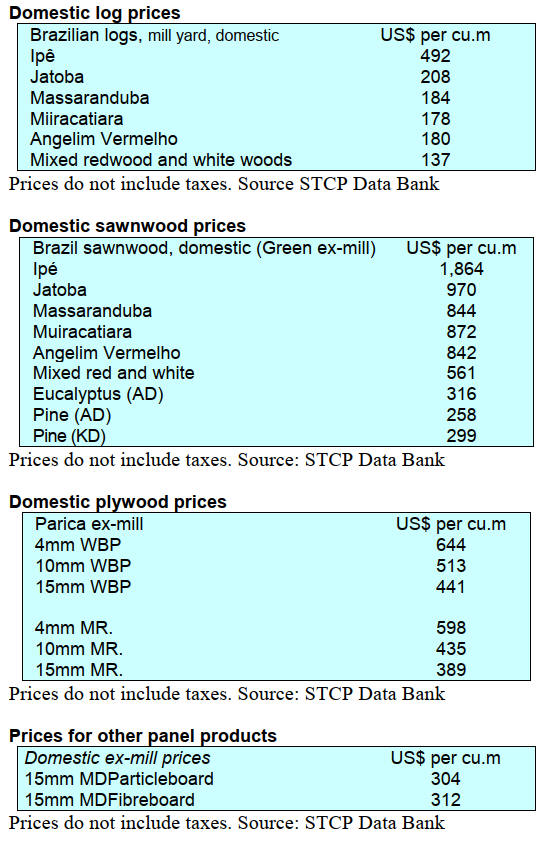
Export prices
Average FOB prices Belém/PA, Paranaguá/PR,
Navegantes/SC and Itajaí/SC Ports.
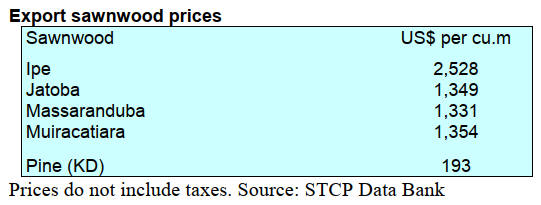 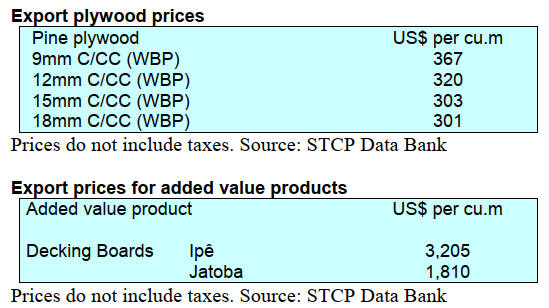
9. PERU
Wooden furniture
shipments recover
Between January and May 2024 wooden furniture exports
were valued at US$0.95 million, an increase of 32%
compared to the same period of the previous year
(US$0.73 million) according to the Services and
Extractive Industries Management unit of the Exporters
Association (ADEX). This amount was the second highest
over the past five years (January-May) since in 2022 when
the figure was just over US$1.1 million.
During the first five months of 2024 furniture exports were
shipped to 15 destinations with 65% to the US followed by
Guatemala which replaced Bermuda for second place.
Other markets were Spain (US$62,741), Italy
(US$47,691), Bermuda (US$41,308), Chile (US$40,801),
France (US$27,324), Puerto Rico (US$15,400),
Dominican Republic (US$3,943) and Panama (US$3,761).
Of the countries mentioned, Bermuda and Panama
experienced the highest growth rates. In contrast exports to
Italy and Chile fell.
Forestry Convention in Pucallpa
The Association of Forestry Producers of Ucayali
(APROFU), the Chamber of Commerce of Ucayali and the
company Tropical Forest will host the first National
Convention of Timber Industrialists to be held in the city
of Pucallpa 21-22 August this year.
This event will bring together public, private, political,
union, academic and professional actors linked to the
forestry sector and the wood forestry products industry in
order to reach agreements and commitments on unifying
proposals to be presented to the government.
During the convention the Forestry Agreement will be
signed between state institutions, private companies and
other stakeholders.
Particleboard imports decreased during the first half of
2024
In the first half of 2024 there was a notable decrease in
particleboard/MDP imports with total import values
falling 17% compared to the same period in 2023. The
import value fell from US$79.5 million in the first half of
2023 to US$66.1 million in 2024.
Ecuador was the main supplier country but experienced a
13% decline with export values falling to US$32.9 million
in the first half of 2024 from the US$38.0 million in the
same period in 2023. Imports from Spain also declined,
dropping 25%.
Brazil was one of the few countries that experienced an
increase in its exports to Peru with an increase of 151%,
reaching a total of US$11.1 million in the first half.
Imports from Chile faced a significant drop of 38%.
Justice operators trained in OSINFOR technological
tools to combat timber trafficking
In a joint effort to strengthen the fight against illegal
timber trafficking the Forest and Wildlife Resources
Monitoring Agency (OSINFOR) and the Environmental
Team of the United Nations Office on Drugs and Crime
(UNODC) organised a workshop to strengthen the
technical capacities of justice operators in Ucayali for the
interpretation and use of information derived from
supervisions with technological and remote sensing tools.
The objective was to strengthen the coordination of justice
system operators regarding the legal framework applicable
to the sustainable use of forest resources and the use of
information tools that contribute to the investigation of
environmental crimes.
Case studies and practical field simulations were presented
allowing participants to apply knowledge in real
situations, including the use of drones and operations
against the trafficking of forest resources.
See: https://www.gob.pe/institucion/osinfor/noticias/963166-
operadores-de-justicia-en-ucayali-se-capacitan-en-el-uso-de-
herramientas-tecnologicas-del-osinfor-para-enfrentar-el-trafico-
de-madera
SERFOR requires declaration of shihuahuaco and
tahuarí stocks
With the entry into force of the inclusion of the
shihuahuaco (Genus Dipteryx) and tahuarí (Genus
Handroanthus) in Appendix II of the Convention on
International Trade in Endangered Species of Wild Fauna
and Flora (CITES) the National Forest and Wildlife
Service (SERFOR) requires companies to declare before
24 November the stocks held of these species.
The provision of CITES allows the export of these after 25
November provided stocks have been declared. SERFOR
will carry out the verifications to confirm the authenticity
of the stock information.
The Director of Sustainable Management of Forest
Heritage in SERFOR reported that there are around 113
processing centres that have stocks of these timbers in the
Departments of Ucayali, Madre de Dios, Loreto, Pasco,
Junín, Huánuco and Cusco.
See: https://www.gob.pe/institucion/serfor/noticias/999750-
serfor-solicita-declarar-stocks-de-shihuahuaco-y-tahuari-hasta-el-
24-de-noviembre

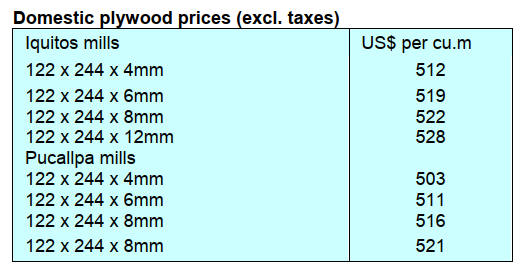
|